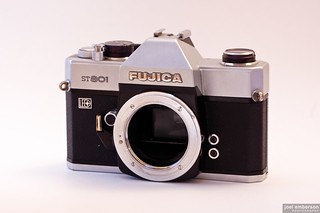Difference between revisions of "Fujica ST801"
(link address correction) |
(→Feature summary: note modified M42 mount for open-aperture metering) |
||
| Line 11: | Line 11: | ||
== Feature summary == | == Feature summary == | ||
| − | * [[M42|M42 mount]] | + | * [[M42|M42 mount]]. Fuji created a modification to the standard 42mm screw mount, adding a very small tab on the back of the aperture ring to communicate with the body's [[light meter]] and permit open-aperture metering. Fuji EBC lenses with this tab will fit on ''most'' other M42-mount camera bodies, but with [[stop down]] metering only. |
* [[TTL]] average [[light meter]], with [[LED]]s | * [[TTL]] average [[light meter]], with [[LED]]s | ||
* open aperture metering using silicon photocells, which are faster and more sensitive than CdS. | * open aperture metering using silicon photocells, which are faster and more sensitive than CdS. | ||
Revision as of 15:16, 4 June 2015
The Fujica ST801 is a manual SLR 35mm film camera made by Fuji between 1972 and 1978. It was the first 35mm SLR to use viewfinder LEDs, replacing the traditional centre-the-needle metering, with a centre-the-light system. This electronic light metering system was developed to eliminate mechanical failure, and needle deviation caused by shocks.
 
|
| with 55mm/1.8 standard lens image by clicks_1000 (Image rights) |
Contents
Feature summary
- M42 mount. Fuji created a modification to the standard 42mm screw mount, adding a very small tab on the back of the aperture ring to communicate with the body's light meter and permit open-aperture metering. Fuji EBC lenses with this tab will fit on most other M42-mount camera bodies, but with stop down metering only.
- TTL average light meter, with LEDs
- open aperture metering using silicon photocells, which are faster and more sensitive than CdS.
- shutter speed up to 1/2000 s
Pros and Cons
Pros
- very bright viewfinder (probably next brightest to Bessaflex)
- LEDs of the light meter are visible in adverse light conditions, and show 3 stops over and under exposure in 1/4 stop increments
- open aperture metering (with Fujinon lenses)
- very compact for it's time.
Cons
- stop-down metering has to be used with non-Fujinon lenses.
- slow flash synchronisation
Gallery

|
| Body only image by Joel Emberson (Image rights) |

|
| black body photo image by Paulo Moreira (Image rights) |

|
| image by Yumi Abe (Image rights) |